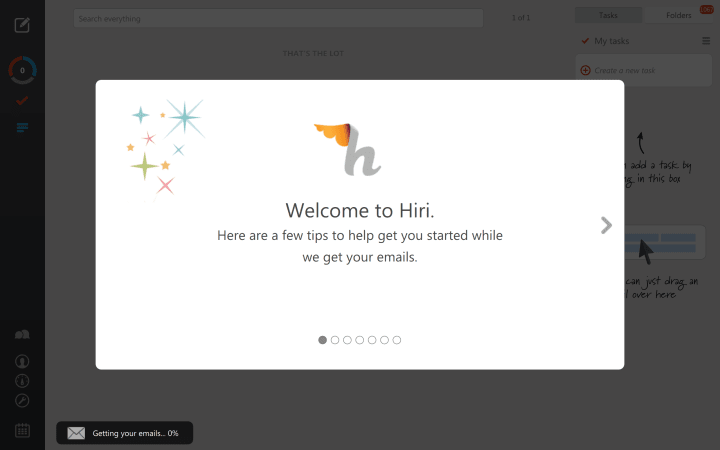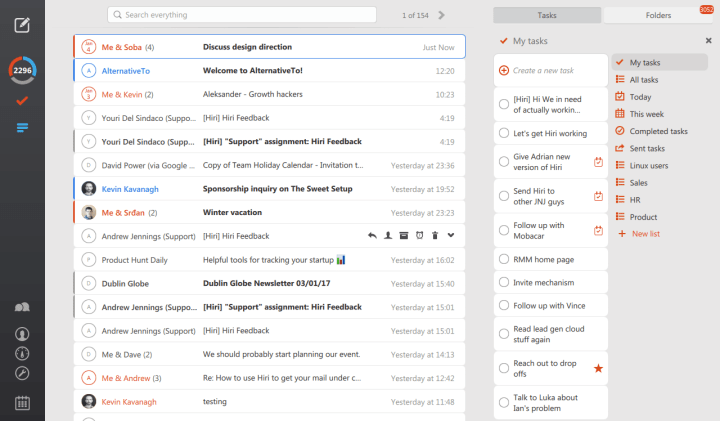luciadecastro
on 18 July 2017
Hiri, the desktop snap that lets you use Microsoft Exchange on Linux

Earlier this month Hiri launched a snap, making their application very easy to be used by Linux users. We talked to Dave Power, co-founder of Hiri, to understand how this journey was and the value of snaps for his business.
Can you tell us what is Hiri about?
Hiri is a desktop email client, designed to help users get their email under control. On average we spend 2.5 to 4 hours a day managing our email at work. It’s especially useful for those that receive a lot of email. We’ve been around for four years. We’re a small team, and It took two years to build Hiri. Building an email client is really hard! Everything has to work. People are very unforgiving if they can’t send or receive their emails.
We’ve been called a ‘replacement for Microsoft Outlook’, but we don’t just want to be seen as a replacement. That would imply that we are simply a pretty clone. We’re trying to do much more than that. Hiri is the product of a lot of research. It actually helps you get good at email.
We chose to support Microsoft Exchange first. This is because 95% of businesses use Exchange as their email server of choice. And surprisingly few email clients work with Exchange as Microsoft intended. We sync all of your emails, labels, calendar items and tasks. We hope to support IMAP in future, but it’s a big piece of work.
We believed that Linux users should have a viable Exchange email client. It was a bit of a gamble. There aren’t many companies producing proprietary software for Linux. There’s a myth out there that Linux users don’t like to pay for software. I’m pleased to say this just isn’t true. Linux users are discerning. They’ll pay for good software. They also want to purchase from a company that is willing to engage with them and work with them. We’ve always believed that it’s our users that design our product – so this was a win-win for us. And quite frankly, the quality of the feedback you get from Linux users is just fantastic. They are techies – product people. The community has been remarkably helpful.
How did you find out about snaps? What was the appeal of snaps that made you decide to invest in them?
Fragmentation is the biggest problem we face on Linux. We spend a significant amount of time supporting Linux users with slightly different setups. A dependency isn’t where it’s supposed to be or there are conflicting systems and app libraries. Snaps just put all of that to bed. We just launched our Snap earlier this month and already I can say with certainty that our users have a lot less trouble installing installing Hiri via the Snap. It’s ridiculously easy. Snaps bring order to the chaos.
I must admit we were a little skeptical when Canonical first approached us. Hiri is a complex app. We didn’t think it was possible to completely confine and sandbox the app. Canonical (shout out to Alan Pope) were very proactive and weren’t afraid to get their hands dirty and mess about with the code themselves. It wasn’t a cakewalk, but soon we had everything we needed, and it works like a charm.

How does building snaps compare to other forms of packaging you produce? How easy was it to integrate with your existing infrastructure and process?
We didn’t really package Hiri for Linux in the past. It was just a zipped tarball. We didn’t want to produce different packages for different distros – an RPM for Fedora, a DEB for Debian and so on. It’s just too much work and too difficult to maintain.
Snaps certainly make life easier. But there were some obstacles. For example, determining all the dependencies that you need to pull in for the application wasn’t straightforward since we use Qt and it needs a ton of stuff to work. This was solved by using desktop-gtk part.
Getting Hiri to work in strict confinement was also quite challenging in our case, but even as we were working on the Snap things were improving. Commercially, I see strict confinement as a good thing. I think people (quite rightly) worry that proprietary software sometimes overreaches in terms of privacy. There’s a trust issue. Snaps give our users peace of mind. Security is an important consideration for our customers.
In terms of process, Snaps help a lot. Hiri is also available on Windows and Mac. We’ve automated the build process for these platforms so it’s easy to publish them and make them live. We can now treat Linux the same way.
Do you currently use the snap store as a way of distributing your software? How do you see the store changing the way users find and install your software?
We do use the Snap store to distribute Hiri. Ubuntu has over 40 million users – that’s a lot of eyeballs. When you finish building your app, you soon realise that reaching the right users can be difficult. You are not Kevin Costner in Field of Dreams – just because you build it, does not mean they will come. The Snap Store puts Hiri front and center. It makes it far more likely that you will discover Hiri and give it a try. And when you do try it, it will work first time!
What are your expectations on savings by using snaps instead of having to package for other distros?
We currently don’t have any plans to package for other distros. We’re going to stick with Snaps. Yes, that will mean leaving some users behind. But they can still install via the tarball. The user experience isn’t as nice, but as mentioned before, there’s just too much work required to support all the different packages.
We’re betting on Snaps. The team at Canonical are doing a wonderful job evangelising the technology and helping spread it to other distros. We’d like to see Linux taking a bite out of the mainstream OS’s. In order to do that, Linux needs to be accessible to the average PC user. Snaps are a step forward in this regard. We’d love to see the wider Linux community embrace Snaps.

What release channels (edge/beta/candidate/stable) in the store are you using or plan to use, if any?
We plan on releasing Hiri on the edge, beta and stable channels. We anticipate that the really brave users will be able to access the daily builds on the edge channel. The beta channel seems like a really good place to test new features and get feedback. It’s a great way to engage with users who wish to have a say in how Hiri evolves whilst managing expectations.
How do you think packaging Hiri as a snap helps your users? Did you get any feedback from them?
Our users are loving the Snap. We’ve even asked many of our long term users who have had issues to switch to the Snap. In 90% of cases this immediately fixes the issue. There has been a notable drop in support cases since we released the Snap. I’d also like to say thanks to the users who helped us to test the Snap on different distros. You just don’t get this kind of support on other platforms. Linux users are engaged, patient and thoughtful. The product is better for their participation.
Canonical have also been uber supportive. I’d encourage anyone who is on the fence about Snaps to reach out to the Canonical team. They’ve been very kind with their time.
How would you improve the snap system?
We love Snaps, but there’s plenty of room for improvement:
smaller download size when installing snaps but the community are already addressing this
We intend to give back to the community and share our experiences. Our CTO spent quite a bit of time investigating Snaps and solving issues. You can expect to see some blog posts in the near future!
If you want to try Hiri you can download it from the Software Center or sudo snap install hiri.


